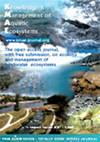Zooplankton communities in a river downstream from a lake restored with hypolimnetic withdrawal
IF 1.7
3区 环境科学与生态学
Q3 FISHERIES
引用次数: 4
Abstract
Restoring lakes with hypolimnetic withdrawal can severely threaten water quality and biocenosis downstream. The objective of this study was to evaluate the effect of lake restoration on riverine zooplankton during a period of intense hypolimnion water inflow. Zooplankton density and biomass were determined in water samples. The water samples were also analyzed to determine the following physicochemical parameters: flow rate, dissolved oxygen, hydrogen sulphide, sulphate, ammonium nitrogen, nitrate nitrogen, total phosphorous, soluble reactive phosphorus, total organic carbon, and temperature. The results of multiple regression indicated that water flow was the most significant variable and was the best predictor of total zooplankton and rotifer density. Soluble reactive phosphorous was the main predictor of copepod biomass and density. Our study showed that hypolimnetic withdrawal disturbed the natural process of planktic community transformation, which was linked to the environmental shift from lacustrine to riverine. During the study, zooplankton density and biomass were low, but not as low as when the pipeline was operating at maximum output. At present, this lake restoration method has become more sustainable, because the adverse effects of hypolimnetic withdrawal on the recipient river have been minimized and limited to several weeks.湖泊下游河流中的浮游动物群落因低激素消退而恢复
低通量回采湖泊的恢复会严重威胁下游的水质和生物群落。本研究的目的是评价在低磷水强烈流入期间湖泊恢复对河流浮游动物的影响。测定了水样中浮游动物的密度和生物量。对水样进行了分析,确定了以下理化参数:流速、溶解氧、硫化氢、硫酸盐、铵态氮、硝态氮、总磷、可溶性活性磷、总有机碳和温度。多元回归结果表明,水流是最显著的变量,是浮游动物总数和轮虫密度的最佳预测因子。可溶性活性磷是桡足动物生物量和密度的主要预测因子。研究表明,低通量退出干扰了浮游生物群落转变的自然过程,这与湖泊向河流的环境转变有关。研究期间,浮游动物密度和生物量较低,但没有管道最大输出时低。目前,这种湖泊恢复方法已经变得更加可持续,因为低激素撤回对接收河流的不利影响已经最小化,并且限制在几周内。
本文章由计算机程序翻译,如有差异,请以英文原文为准。
求助全文
约1分钟内获得全文
求助全文
来源期刊

Knowledge and Management of Aquatic Ecosystems
环境科学-海洋与淡水生物学
CiteScore
3.70
自引率
5.60%
发文量
22
审稿时长
>12 weeks
期刊介绍:
Knowledge and Management of Aquatic Ecosystems (KMAE-Bulletin Français de la Pêche et de la Pisciculture since 1928) serves as a foundation for scientific advice across the broad spectrum of management and conservation issues related to freshwater ecosystems.
The journal publishes articles, short communications, reviews, comments and replies that contribute to a scientific understanding of freshwater ecosystems and the impact of human activities upon these systems. Its scope includes economic, social, and public administration studies, in so far as they are directly concerned with the management of freshwater ecosystems (e.g. European Water Framework Directive, USA Clean Water Act, Canadian Water Quality Guidelines, …) and prove of general interest to freshwater specialists. Papers on insular freshwater ecosystems and on transitional waters are welcome. KMAE is not a preferred journal for taxonomical, physiological, biological, toxicological studies, unless a clear link to ecological aspects can be established. Articles with a very descriptive content can be accepted if they are part of a broader ecological context.
 求助内容:
求助内容: 应助结果提醒方式:
应助结果提醒方式:


